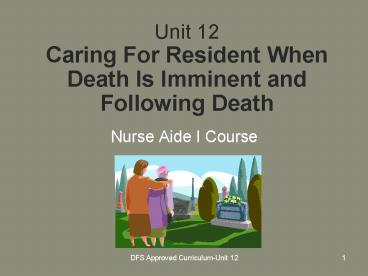Unit 12 Caring For Resident When Death Is Imminent and Following Death - PowerPoint PPT Presentation
1 / 63
Title:
Unit 12 Caring For Resident When Death Is Imminent and Following Death
Description:
Unit 12 Caring For Resident When Death Is Imminent and Following Death Nurse Aide I Course – PowerPoint PPT presentation
Number of Views:342
Avg rating:3.0/5.0
Title: Unit 12 Caring For Resident When Death Is Imminent and Following Death
1
Unit 12Caring For Resident When Death Is
Imminent and Following Death
- Nurse Aide I Course
2
Caring for Resident When Death Is Imminent and
Following Death
- Introduction
- Death is defined as the final stage of life. ?
The nurse aide will need to develop a realistic
attitude toward the topic of death to meet the
physical and psychological needs of the resident
and the family as they experience the dying
process. ? This unit also includes care of the
body following death.
3
Factors Influencing Attitudes
4
- 12.0 Explore personal feelings concerning the
concept of death.
5
Caring For Resident When Death Is Imminent and
Following Death
- Factors influencing attitudes
- Personal experiences
- Culture
- Some fear death
- Others look forward to and accept death
6
Caring For Resident When Death Is Imminent and
Following Death(continued)
- Factors influencing attitudes
- Religion
- Belief in life after death
- Reunion with loved ones
- Reincarnation
- Punishment for sins
- No afterlife
7
Caring For Resident When Death Is Imminent and
Following Death(continued)
- Factors influencing attitudes
- Age
- Children view death as temporary
8
Caring For Resident When Death Is Imminent and
Following Death(continued)
- Factors influencing attitudes
- Age
- Adults may develop fears of
- pain and suffering
- dying alone
- separation from loved ones
- Elderly generally have fewer fears
9
Special Needs Of Dying Resident
10
- 12.1 Identify the special needs of a dying
resident.
11
Special Needs Of Dying Resident
- Visits with family/significant others
- Features of residents room
- pleasant as possible
- lighting that meets residents preferences
- well ventilated
- odor free
12
Special Needs Of Dying Resident(continued)
- Features of residents room
- Contains personal items which provide comfort and
reassurance - Pictures
- Mementos
- Cards
- Flowers
- Religious objects
13
- 12.2 Identify eight comfort measures that may be
used with the dying resident.
14
Special Needs Of Dying Resident(continued)
- Comfort Measures
- Attention to skin care
- Good personal hygiene
- Oral hygiene - denture care
- Bedding changed as needed
- Back massages
15
Special Needs Of Dying Resident(continued)
- Comfort Measures
- Frequent position changes
- every two hours
- P.R.N.
- Good body alignment
- supportive devices
- prevention of deformities and pressure ulcers
16
Special Needs Of Dying Resident(continued)
- Comfort Measures
- Head of bed elevated to facilitate breathing
- Modified diet
17
Caring For Residents When Death Is Imminent
And Following Death
Nurse Aide's Role
18
- 12.3 Describe the nurse aides role in
relationship to the to the needs of the dying.
19
Caring For Resident When Death Is Imminent and
Following DeathNurse Aides Role
- Source of strength and comfort
- Open and receptive
- Know own feelings about death and do not project
those feelings onto resident.
20
Caring For Resident When Death Is Imminent and
Following DeathNurse Aides Role(continued)
- Empathetic
- Calm and efficient
- Normal tone of voice
- Good listening skills
- Non-judgmental
21
Individual Resident's Reaction to Death
22
- 12.4 Review the various reactions residents may
have as they face death.
23
Individual Residents Reaction To Death
- Accept or be resigned to death
- Open and receptive
- Communicate about uncertainties
- Fearful or angry
- Despairing and anxious
- Hostile
- Thoughtful and meditative
24
Five Stages Of Grief, Death And Dying As
Described By Dr. Elisabeth Kubler-Ross
25
- 12.5 List and describe the five stages of grief,
death and dying.
26
Five Stages of Grief, Death and Dying as
Described by Dr. Elizabeth Kubler-Ross
- DENIAL
- Defense mechanism
- Buffer against reality
- Emotional escape hatch
- Resident may request another opinion
27
Five Stages of Grief, Death and Dying as
Described by Dr. Elizabeth Kubler-Ross
- DENIAL (continued)
- Resident may avoid discussion of death
- Feeling of, This cant be happening to me.
28
Five Stages of Grief, Death and Dying as
Described by Dr. Elizabeth Kubler-Ross
- ANGER
- Bitterness and turmoil
- Sense of unfairness
- Blame of others such as health care workers
- Feeling of, Why me?
29
Five Stages of Grief, Death and Dying as
Described by Dr. Elizabeth Kubler-Ross
- BARGAINING
- Turn to religious and spiritual beliefs
- Promises to God and others
- Comfort and hope when all seems lost
30
Five Stages of Grief, Death and Dying as
Described by Dr. Elizabeth Kubler-Ross
- BARGAINING (continued)
- Generally know this wont work
- Frustration and anger dissolve into depression
- If only...I will
31
Five Stages of Grief, Death and Dying as
Described by Dr. Elizabeth Kubler-Ross
- DEPRESSION
- Belief that hope is lost
- Overwhelming despair
- Introverted and withdrawn
- Reminiscing and reviewing life
- Sleeplessness
- I always wanted to
32
Five Stages of Grief, Death and Dying as
Described by Dr. Elizabeth Kubler-Ross
- ACCEPTANCE
- Calm and subdued interest in life
- Strives to complete unfinished business
- Helps loved ones accept death
- Needs others to validate worth of life
- Ive had a good life.
33
Signs of Approaching Death
34
- 12.6 Recognize the signs of approaching death.
35
Signs Of Approaching Death
- Changes in sensory functions and ability to speak
- Vision
- increased secretions in corner of eyes
- blurred vision
- failing vision
- no eye movement/staring
36
Signs Of Approaching Death
- Changes in sensory functions and ability to speak
(continued) - Speech
- becomes difficult
- hard to understand
- may be unable to speak
- Hearing - last function to be lost
37
Signs Of Approaching Death
- Changes in circulation and muscle tone
- Circulation
- fails
- heat gradually lost from body
- hands and feet cold to touch and mottled
- face becomes pale or gray and mottled
- perspiration may increase (diaphoresis)
38
Signs Of Approaching Death
- Changes in circulation and muscle tone
(continued) - Muscle tone
- body limp
- jaw may drop
- mouth may stay partly open
39
Signs Of Approaching Death
- Changes in Vital Signs
- Respirations
- slower
- shallow
- labored
- may experience dyspnea, apnea, Cheyne-Stokes
- mucous collects in the throat and bronchial tubes
(death rattle)
40
Signs Of Approaching Death
- Changes in Vital Signs (continued)
- Pulse
- rapid
- weak and irregular
- Blood pressure drops
- Temperature
- elevated
- subnormal
41
Signs Of Approaching Death
- Urinary and anal incontinence
- Decreased peristalsis, abdominal distention
- Release of flatus
- Decreased pain
- Loss of consciousness
42
Nurse Aide's Role In Spiritual Preparation For
Death
43
- 12.7 Define the role of the nurse aide in the
spiritual preparation for death. - 12.8 Contrast the spiritual preparation for death
practiced by those of various religions.
44
Nurse Aides Role In Spiritual Preparation For
Death
- Priest, rabbi, minister or other clergy may be
contacted at request of resident or family - Privacy to be provided when clergy with resident
45
Nurse Aides Role In Spiritual Preparation For
Death(continued)
- Support residents religious/spiritual practices
even if different from that of nurse aide - Listen respectfully to religious/spiritual
beliefs - Participate in religious practices if asked and
acceptable
46
Nurse Aides Role In Spiritual Preparation For
Death(continued)
- Treat religious objects with care and respect
- medals
- pictures
- statues
- bibles
- Encourage family and friends to be included
47
Nurse Aide's Role In Meeting Family Needs
48
- 12.9 Identify the needs of the family as they
encounter the dying process.
49
Nurse Aides Role In Meeting Family Needs
- Available for support
- Use touch as appropriate
- Courteous and considerate
- Respect right to privacy
- Let family assist with care, if they desire,
where appropriate
50
Nurse Aides Role In Meeting Family
Needs(continued)
- Use good communication skills
- Listen and provide understanding throughout the
grief/loss stages - Answer questions or refer to supervisor
51
Hospice Care
52
- 12.10 Discuss the hospice philosophy.
53
Hospice Care
- Health care service offered
- in hospitals and extended care facilities
- by special facilities
- usually in the individuals home
- Continuing care provided by team of health
professionals - Designed for residents with terminal illness
54
Hospice Care(continued)
- Acceptance of death as imminent (6 months or
less) - Assures that individual dies with dignity and
comfort - Not concerned with cure or life-saving procedures
- Emphasis on pain relief
- Trained volunteers and professionals make regular
visits.
55
Hospice Care(continued)
- Provides counseling for individual and family
- Emotional
- Psychological
- Spiritual
- Financial
- Bereavement
- Family included in all aspects of care as desired
56
Postmortem Care Care Of The Body After (Post)
Death (Mortem)
57
- 12.11 Discuss the meaning of postmortem care.
58
Postmortem Care
- Care Of Body After (Post) Death (Mortem)
- Begin care when instructed by supervisor
- Treat body to privacy, respect and gentleness
- Give care before rigor mortis sets in
59
- 12.12 List five reasons for doing postmortem
care.
60
Postmortem Care(continued)
- Reasons for Postmortem Care
- Prevent discoloration and skin damage
- Maintain good appearance of body
- Identify body and prepare for transportation
- Position body in normal alignment
- Arrange time family to view the body
61
Demonstration and Return Demonstration
62
- 12.13 Demonstrate the procedure for postmortem
care.
63
The End































